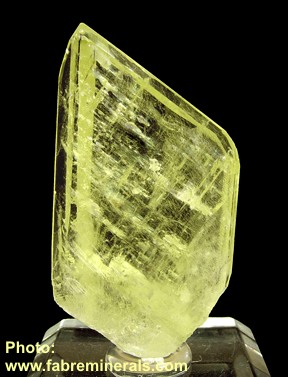| Crystal system | Triclinic |
| Transparency | Transparent |
| Luster | Pearly to vitreous |
| Fracture | Conchoidal |
| Cleavage | Perfect basal |
| Specific Gravity | 3.02 |
| Hardness | 6 |
| Optical Character | Biaxial +-, Double Refractive |
| Refractive index | 1.612-1.636 |
| Birefringence | 0.024 |
| Fluorescence | Very weak green |
| Pleochroism | Weak |
| Chemical Formula | (Li,Na)AlPO4(F,OH) |
| Comments | Powder dissolves slowly in HCL, somewhat faster in H2SO4 |
Pronounced am-BLIG-oh-nite, this fluo-phosphate of aluminum and lithium (Li,Na)AlPO4(F,OH) is only rarely seen as a cut gem. The name comes from two Greek words meaning "blunt" and "angle", in allusion to the habit of the triclinic crystals. It most commonly occurs, however, in cleavable, columnar, or compact masses. Colors vary from white through pale pink, green, blue, yellow and brown. Transparent stones are usually almost colorless to light yellow to greenish yellow and resemble cut specimens of spodumene.
The rare gem crystals occur in pegmatites with tourmaline, quartz, apatite, lepidolite, and spodumene. The mineral is found at Arendal, Norway; Penig, Saxony; Brazil; South-West Africa; Maine; Connecticut; South Dakota; Southern California; and Tasquilon, Spain. It has a hardness of 6, a conchoidal fracture, specific gravity near 3.02, a pearly to vitreous luster, basal cleavage, and a white streak. The R.I.'s of gem material are usually near 1.612 - 1.636, but may be .010 lower.
It is biaxial and may be either negative or positive in sign, depending on the proportion of fluorine to hydroxyl.
The rarity, pale colors and relative lack of durability of amblygonite serve to confine interest in the mineral to collectors.


